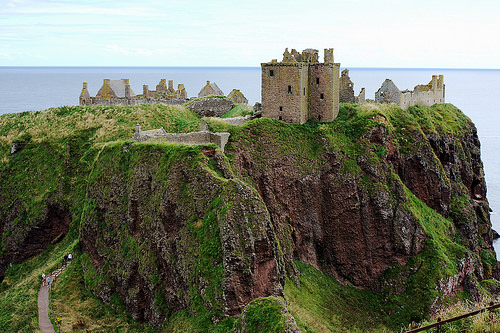Dunnottar Castle famous for its romantic spots and… constant destruction.
- Dunnottar Castle is a ruined castle located in Scotland’s north east, in the United Kingdom in Europe, that was originally built in the medieval period.
- Dunnottar Castle covers an area of 3.5 acres (1.4 hectares), and sits on a sea cliff that rises to 50 metres (160 feet) in height.
- ‘Dùn Fhoithear’ is the Scottish-Gaelic for Dunnottar Castle, and means ‘fort on the shelving slope’.
- The date the first castle was built on the Dunnottar Castle site is uncertain, although it, or a fort, was possibly erected before the 7th century, as there is reference to a siege in the area in the late 600s.
- Dunnottar Castle was a significant administration location in the county, under the rule of King William the Lion who reigned from 1165 to 1214.
Dunnottar Castle
Image courtesy of Christian Kadluba/Flickr
- Dunnottar Castle was bought in 1720 by the York Buildings Company, who removed much of the interior including the floors and roof.
- Restoration of some parts of Dunnottar Castle began after new owner, the 1st Viscount Cowdray, Weetman Pearson from Yorkshire in England, purchased the property in 1925, and it was eventually passed down to one of his great grandsons, Charles Pearson, who was the owner in 2014.
- Dunnottar Castle is open to the public and has become a popular tourist attraction, and was visited by approximately 52,000 tourists in 2009.
- William Keith, a Marischal of Scotland, and his family, were the predominant owners of Dunnottar Castle from the 1300s to 1700s, and it was seized from them by the king in 1716.
- Throughout its history, Dunnottar Castle was burnt to the ground a number of times, sometimes by the Scottish to kill the invading English.
Bibliography:
Dunnottar Castle, 2014, Wikipedia, http://en.wikipedia.org/wiki/Dunnottar_Castle
Ross D, Dunnottar Castle, n.d, Britain Express, http://www.britainexpress.com/scotland/ruins/Dunnottar-Castle.htm







